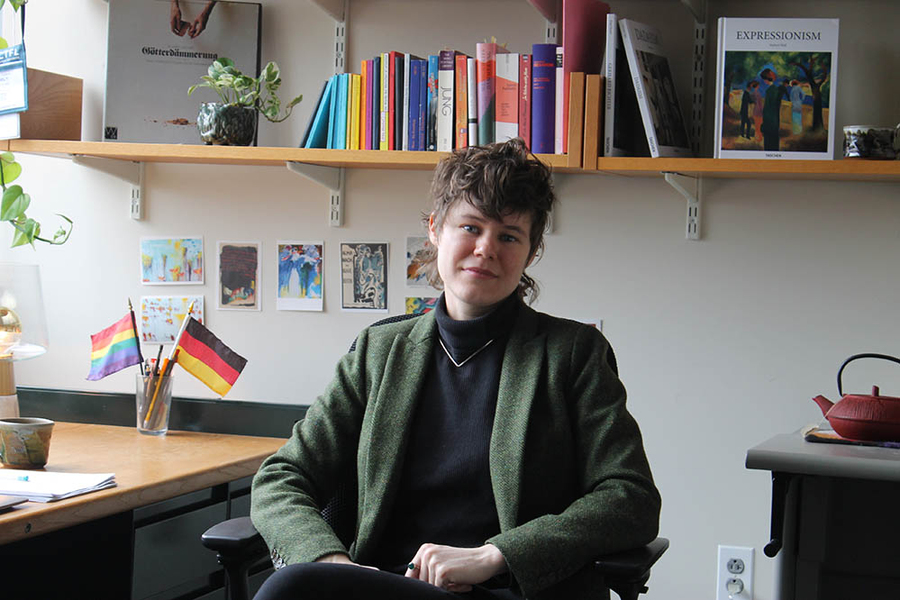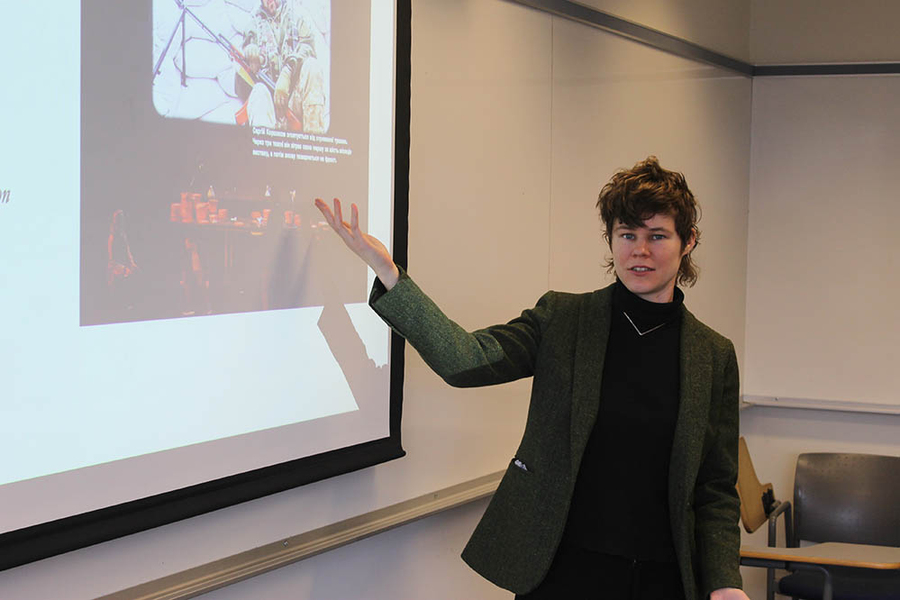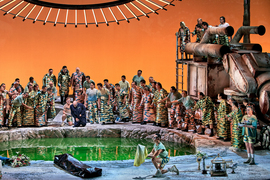Emily Goodling is a lecturer in German in Global Languages at MIT. She teaches class 21G.411 (Conflict, Contest, Controversy: A Literary Investigation of German Politics), a new course offered last fall. Goodling developed the course with the help of an MIT Global Languages Consortium for Language Teaching and Learning Innovation in Language Pedagogy grant in summer 2023. With the support of an Artists in the Classroom grant from the MIT Center for Art, Science and Technology, she hosted virtual presentations to her class by Stas Zhyrkov, a displaced Ukrainian theater maker working in Germany, and Christoph Buchegger, a young artistic production manager at Berlin’s Schaubühne theater. Here, she discusses the impetus for designing this class as well as its outcomes.
Q: Why study theater in a German language class?
A: Theater is incredibly effective in the second-language classroom, and I’ve found that it is also of particular interest to our students. At MIT, we use the “communicative approach” — that is, we focus on using language in real-life situations as opposed to rote memorization of grammar or vocabulary. And what is theater? It’s communication, dialogue. In live theater, or even while watching a recording of live theater, not only are you hearing a conversation, but you're also observing things like gesture, intonation, and the melody of a spoken language in real-time. This is an incredibly helpful model for students who are learning a language.
Also, this theater is deeply intercultural in nature. Particularly over the last decade or so, some main-stage, state-funded theaters in Germany have broken down borders to bring new voices to the stage, and are expanding the idea of what German theater — and Germany itself — is and can be. This richness, I think, resonates with the diverse and international student body in my classes every day. These works also feel very urgent: They rest on the foundation of a long tradition in Germany of political theater that has been used as a nation-building or nation-critiquing exercise. This theater poses big questions: What does it mean to be German? Who or what is German? How can we understand German history? Bringing those questions to light through real people on a live stage immediately ups the level of intensity.
Q: You were in Germany last summer doing research. What did you discover?
A: I went to Berlin to look for materials on Germany's political and artistic response to the war in Ukraine. I saw street art, posters, talks, films, and museum installations. But one theater piece really stood out to me, and I knew I wanted to bring it to my students at MIT: “Sich waffnend gegen eine See von Plagen,” by Ukrainian director Stas Zhyrkov, at the Schaubühne theater. The name of the play in English is from Hamlet’s famous soliloquy: “to take arms against a sea of troubles.” Thanks to the generosity of the folks at the Schaubühne, I was able to get a filmed version of the production as well as the text, and I hired a young Ukrainian woman in Cambridge to translate the Ukrainian sections of the play into English — of course, my students read the German sections in German! I told them, “You're holding in your hands a piece of art that no other students anywhere are looking at right now. It's just you guys.” It felt like such a privilege to be able to look at the production together.
I was able to arrange for Stas Zhyrkov to give a virtual presentation to my class. He introduced himself and the project, and then there was just a really free-floating dialogue between him and the students. He was so articulate, candid, and generous, although the conversation was also very heavy at times: This is a person from a country that is actively at war, and that war has had enormous personal, political, artistic, and professional consequences in his life. He talked about losing members of his theater ensemble back in Kiev, and about the decision that artists had to make when the war started: “Do I take up arms and go to the front lines? Or do I continue making art, potentially outside of Ukraine?” He spoke about his own decision to leave and make theater about the situation from outside the country. The fraught nature of that decision, and the pain that accompanied it — I think this is what we all took away from that conversation. I asked him about how he envisions making theater in Ukraine when the war is over. He said that he sees theater as a means of coming to terms with what happened, an art form that can propose a kind of psychological way forward for the country. But he realizes that back home he may not be seen as a hero, because he chose to leave.
I also organized a virtual conversation with Christoph Buchegger, who is the artistic production manager for the Schaubühne and also has ties to Broadway and U.S. theater in general. With him, we explored the differences between the German and American theater scenes: On the German stage, for instance, audiences aren’t going to see comedy or entertainment — as Christoph said, sometimes their lighter pieces don’t sell well at all! Instead, audiences want to see complex, jarring, and difficult pieces, even in traditional, state-funded institutions that have been around for hundreds of years. Because these theaters receive so much external funding, in contrast to most U.S. institutions, there isn't so much pressure to sell tickets, or even to be pleasing to an audience. In fact it's often the opposite: Directors desire to challenge — and sometimes even be aggressive towards — the people who are sitting in the seats. It's an entirely different orientation. In my seminar, students explored many different genres of political art, from visual forms of propaganda to poetry and film, but theater always seemed to provoke the strongest reactions; Christoph’s contextualization helped explain why.
Q: How did you help your students tackle the material?
A: This is an upper-level German course. The earlier levels are more focused on using cultural content to give students an explicit foundation in German grammar and vocabulary, and introduce them to some key cultural discussions and topics. My class is focused on using cultural content to dig deep into politico-artistic moments from the past century of German history — while of course still honing students’ communicative and grammatical skills! To that end, I provided students with scaffolding activities to help them approach such complex works. This gave them both the necessary vocabulary and grammar as well as a sense of their historical, political, and cultural background. In class, however, my primary goal was making space for informed, rigorous, open-ended discussion. I was just blown away by the students and the level of the dialogues we were able to have; it was an honor to get to talk about these materials with such open-minded and curious individuals. They brought their own backgrounds, experiences, and perspectives to these materials in ways that really opened my eyes.











